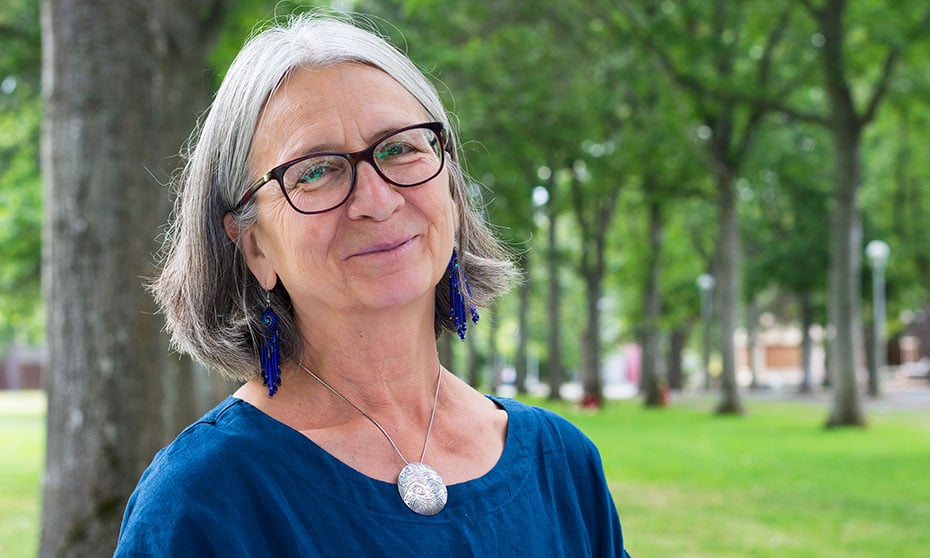The member of B.C.’s Saulteau First Nation was a grandmother when she began law school

Dr. Val Napoleon is an associate professor and Law Foundation Professor of Aboriginal Justice and Governance at the University of Victoria. She co-founded the Indigenous Law Research Unit and the Joint Degree Program in Canadian Common Law and Indigenous Legal Orders JD/JID that launched last September. In June, she was honoured with a Lexpert Zenith award for the latter achievement. She spoke to Canadian Lawyer about her beginnings, her work and her passions.
Canadian Lawyer: Tell me about yourself; what drew you to your present career path?
Val Napoleon: I’m from northeast B.C., from Saulteau First Nation [Cree], but I’m also an adopted member of the Gitanyow [northernmost Gitksan community] House of Luuxhon, Ganada (Frog) Clan.
As a grandmother, I went to law school and took my doctorate in law. There are two stories there: one is, my daughter got pregnant, and I wanted to say waise things to my grandchild. One thing I wanted to say most of all was, if you want to do something, you’ve just got to go and do it; no one will do it for you.
I’d applied to law school in my early twenties, and I was accepted but didn’t go. Life happened. I had worked in education, social services and justice projects, but what I saw was that older Indigenous women disappeared. And a law degree is a really good driver’s licence in the world. I became a member of the Law Society of B.C. and found that it was not so much the practice of law I found interesting but the research and theory. Research was not being done the way I wanted; there was Hadley Friedland, Renée McBeth [Beausoleil] and myself at law school. Eventually, the [Victoria] law school gave us a sign, “Indigenous Law Research Unit.” We kept working at it, and now it’s a real thing, a going concern.
Earlier I taught at the University of Alberta; I was cross-appointed to the Faculty of Native Studies and the law school before coming to Victoria, where I have an endowed chair through the Law Foundation of B.C. I’m the director of the Indigenous Law Research Unit, and the Indigenous Law Degree Program (JID). It’s a combined JID/JD program. (See sidebar.)
In 2001, I was called to the bar of B.C. and I maintained that membership until I’d been teaching for a while.
CL: What are your hopes for the first Indigenous law program? Would you like to see it expand elsewhere in Canada or the world?
VN: Absolutely; I think that that’s inevitable. As people can see Indigenous law as law, as having accountability, structure, institutions — if you think about all the ways Canadian law is part of your life, your identity as a Canadian, your work life, your ability to navigate in the world . . . all of that is why Indigenous people want to rebuild their law and to figure out how that then relates to Canada.
And there are serious issues. If we think about missing and murdered Indigenous women and girls, from my perspective, the undermining and destruction of Indigenous law has created lawlessness, and Canadian law has also failed. It has created a lack of safety for Indigenous women and girls, and our work is about rebuilding safety, including inclusion and fairness and protection and accountability — all the things people want for their communities, for their grandkids.
In the Indigenous Legal Research Unit, we create educational materials and share them. There’s a graphic narrative on Cree criminal law [that is] used in Canada, and a 100-page teaching guide that goes with it. We’ve almost finished a Cowichan water law graphic narrative. We’ve been developing materials that aren’t just for academics but [are] alongside the academic papers that we also write.
But there needs to be lots of conversation around what law is; what makes law law? How does it work? What are the standards of legitimacy? What does it mean to be accountable? These are questions that not just Indigenous people but all people should be asking.
Painting as passion: grandmother trickster ravens
Napoleon is also a painter, and her jet-black feathered subjects wear little kerchiefs. “I paint grandmother ravens; they’re tricksters, and they’re born and reborn of Indigenous feminist consciousness, and they’re female, because . . . the way tricksters are talked about is as if they’re only male. And they’re old, because there are so many stereotypes about older Indigenous women. So, they’re grandmother tricksters, and they’re kickass! . . . We sell raven cards as part of our fundraising for the [Indigenous Legal] Research Unit. It’s the academic version of a bake sale.”
Fast Facts
Indigenous Law Research Unit: Established in 2012 and housed at the University of Victoria law school, it provides public legal education. It works with the Indigenous community by invitation, researching and articulating Indigenous laws regarding land and resources. The main source of law drawn on is from oral histories and narratives, which are analyzed, and law reports for the community partner is then based on that analysis. The ILRU has worked with communities across Canada, from Micmac in Nova Scotia, to northern Alberta, northern B.C. and Ontario, on issues including water sustainability and management; lands and resources; and harms and injuries. Current projects include child welfare, and human rights within Gitksan law.
The ILRU employs four staff and hires and trains graduate and law students as well as lawyers. It is credited with building a profile for Indigenous law that helped get support for the Indigenous law degree program.
Joint Degree Program in Canadian Common Law and Indigenous Legal Orders JD/JID: Started by Napoleon and John Burrows at the University of Victoria, the program welcomed its first cohort of students in September 2018 and is unique in the world. It’s a four-year professional degree program in which students receive both a Canadian and an Indigenous law degree; the first two years of the program are the equivalent of a regular law degree, but students study Indigenous law alongside Canadian. Napoleon has taught land and property law, John Burrows Anishinaabe and Canadian Constitutional law, and David Milward Cree and Canadian criminal law. The program was modelled on McGill University Law’s program of teaching civil and common law together.
Global reach: Inquiries have come from around the world regarding how the joint degree program works. Napoleon travelled to New Zealand in August to talk about Indigenous law issues and what it means to teach Indigenous law. Burrows also travels extensively, including to Australia, and the ILRU has given workshops in places as far-flung as Oslo and South Africa.
Family, early years and activism: Napoleon has one daughter, and a niece who lived with her over the years, “so, her kids are like our kids.” Four grandsons range in age from two years old to nearly 21, in Victoria and Vancouver. Growing up in northeastern B.C., partly on the Saulteau First Nation reserve, where the Napoleons are a large family, she says, “I think that my life . . . was pretty typical of Indigenous people: lots of hardships and lots of amazing magic, too.” At age 17, Napoleon moved to the Smithers-Hazelton area of B.C., was introduced to the Gitksan people and grew into adulthood. There she worked on the Delgamuukw action that became the first aboriginal title case in Canada (Delgamuukw v. British Columbia [1997] 3 SCR 1010) and “heard people talk about their laws, and working hard to make their laws visible to the rest of Canada. That was an incredible opportunity and education; I was so lucky to be a part of that as a young woman.”










